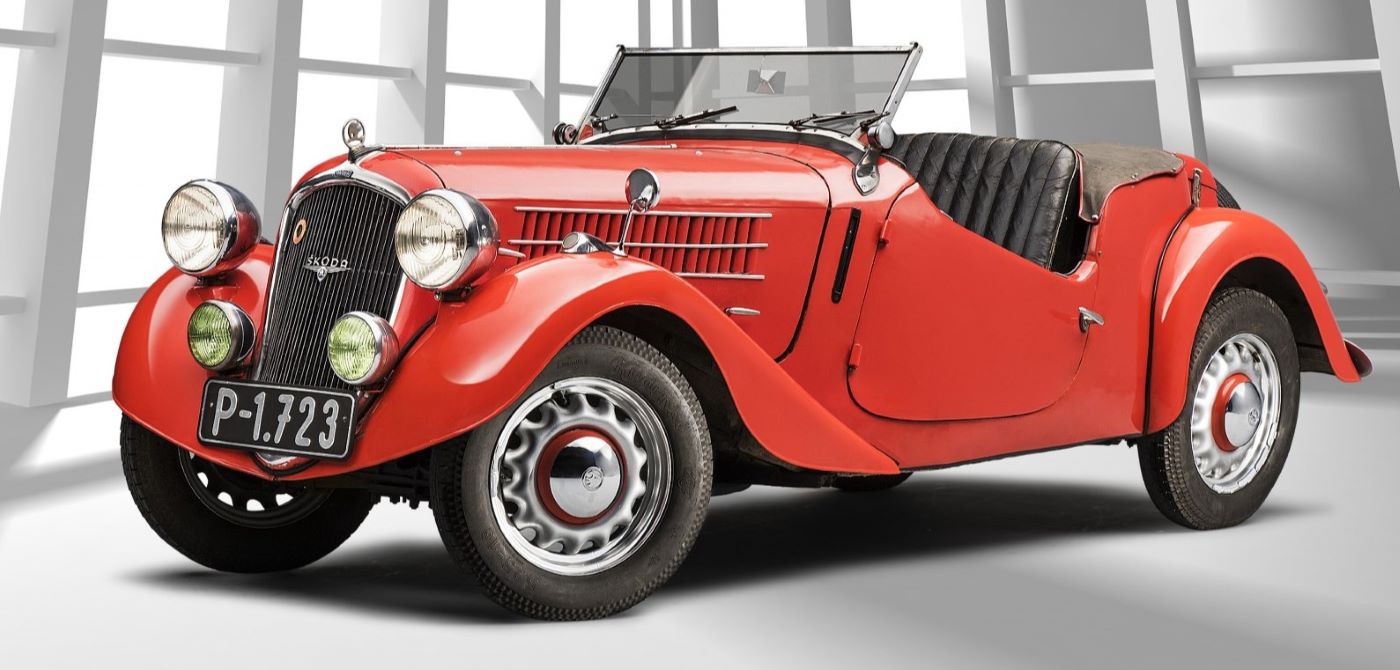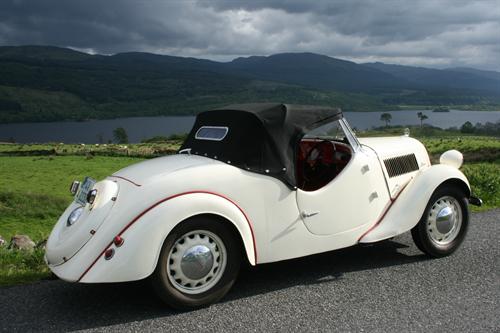
In January 1936, the ŠKODA POPULAR roadster took second place in the Monte Carlo Rally in the under 1,500 cm3 class
› The team tested their leather overalls, heating and Baťa tyres with off-road tread in the snow-covered Giant Mountains
› Limited-edition series model ŠKODA POPULAR MONTE CARLO set standards in both technology and design
Mladá Boleslav, 1 June 2021 – 85 years ago, Zdeněk Pohl and Jaroslav Hausman set off from Mladá Boleslav for the famous Monte Carlo Rally in their ŠKODA POPULAR SPORT. In the principality of Monaco, they drove the roadster to one of the greatest successes in ŠKODA AUTO’s motorsport history.
The Monte Carlo Rally, which is as famous as it is demanding, was first held in 1911 to attract tourists even during the cold winter months to the Principality of Monaco. Zdeněk Pohl and Jaroslav Hausman took part in the fifteenth run, which took place from 25 January to 2 February 1936, with the ŠKODA POPULAR SPORT and impressively held their own against the competition.
Since the length and difficulty of the route from the official starting point were also decisive for success in the Monte Carlo Rally, Pohl and Hausman set off from Athens and travelled via the Riviera to Monaco. Other possible starting points included Bucharest, Palermo, Stavanger or Tallinn. Within 17 hours, the pair had covered 850 kilometres from Prague to the ferry in Trieste in their ŠKODA POPULAR SPORT. After arriving in the Greek metropolis of Athens, Zdeněk Pohl and Jaroslav Hausman had four days to recover and prepare their vehicle technically for the rally – without the assistance of a mechanic or professionally equipped service vehicle.
The 3,852-kilometre journey via Thessaloniki, Belgrade, Budapest, Vienna, Strasbourg and Avignon to Monaco took four days in total. Pohl later recalled, “I saw strange things along the way. On one occasion, a horse was reversing towards us at full speed; another time, I had to dodge an elephant. The road was clear, of course – we were hallucinating after four nights without sleep. The hum of the engine made us tired, plus it was very foggy.”
Out of the 105 teams registered, only 72 vehicles finished the Monte Carlo Rally in 1936. The ŠKODA POPULAR SPORT reached the finish without any penalty points, and it also passed the technical inspection and did well in the skill test. This secured second place for Pohl and Hausman in the under 1,500 cm3 class.
Their success with the ŠKODA POPULAR SPORT was the result of careful preparation. For example, the duo tested their leather overalls and off-road Baťa tyres in the snowy Giant Mountains. Since the pair could not agree during the preparation whether a wooden or tin shovel would be better suited to freeing the car from the snow, they ultimately packed both options.
The ŠKODA POPULAR SPORT was fitted with the modified chassis of the lighter POPULAR series, but the engine came from the more powerful RAPID. The four-cylinder with a displacement of 1,386 cm3 generated an output of 34 hp, the top speed was around 110 km/h. New Ate-brand hydraulic brakes improved the braking performance. Two fuel tanks with a total capacity of 170 litres guaranteed a range of 1,500 km; consumption was 11.3 litres per 100 km. Its total weight was 790 kilograms, of which the open body accounted for only 250 kilograms. The fully loaded POPULAR weighed in at around 960 kg, plus 170 kg for the driver and front passenger. During the cold season, Pohl and Hausman benefited from the hot air heating as well as a holder for a thermos flask and the partially heated windscreen. The folding passenger seat also came in handy, allowing the co-pilot to rest during the journey.
The automobile manufacturer from Mladá Boleslav took their great success at the Monte Carlo Rally as an opportunity to expand the model range to include an exclusive series of sports vehicles. The first ŠKODA POPULAR MONTE CARLO roadster was delivered in July 1936, followed by the first coupé in August 1936. The official presentation was held at the Paris Motor Show on 1 October 1936. By 1939, ŠKODA had built around 70 roadsters and coupés in the series, and customers included the then fourteen-year-old Yugoslav King Petar II Karađorđević.
One of these vehicles has been part of the ŠKODA Museum collection since 1968. The black POPULAR MONTE CARLO coupé from 1937 is one of only twenty surviving copies. It was painstakingly restored in the early 2000s and has since been attracting attention at classic car events at home and abroad.
The design of the models with their characteristic headlights and lattice in front of the radiator grille is influenced by the style of the interwar period. With its elegantly curved lines, the ŠKODA POPULAR MONTE CARLO is still a design icon in the company’s history. Today, the ‘MONTE CARLO’ equipment line for the FABIA, SCALA and KAMIQ model series commemorates ŠKODA’s great motorsport successes at the rally in the Principality of Monaco.



Cheering at the 1936 Monte Carlo Rally: ŠKODA Popular takes second place in <1500 cm3 class
“ŠKODA is proud of their long tradition in motorsport,” said ŠKODA Michal Hrabánek, Director of ŠKODA Motorsport. “In the 1930s, the ŠKODA Popular celebrated similar success as the current ŠKODA Fabia R5 rally car. The successes of our predecessors are a great motivation for us. In the 2015 season, the new ŠKODA Fabia R5 brought us four victories in the WRC 2, five national titles and the fourth APRC champion title in a row.”
“The technical concept of the ŠKODA Popular, with the then state-of-the-art central tube frame, independent suspension front and rear and the transaxle arrangement was in many ways ahead of its time,” explains Michal Velebný, coordinator of the restoration workshop at the ŠKODA Museum in Mladá Boleslav. “The ŠKODA Popular scored significant successes both in Europe and South America on the racing and rally tracks.”
Along with the Rapid and Superb models, in 1934 the ŠKODA Popular laid the foundation for the rise of ŠKODA in the 1930s to become the best-selling brand in their Czechoslovak home market and a recognized car brand in Europe. In their time, the vehicles set standards in terms of technology, design and value for money.
The ŠKODA Popular, which was on the starting line of the Monte Carlo Rally 80 years ago, had a three-speed transmission and an engine from the Rapid model series. The four-cylinder engine with a displacement of 1386 cubic centimetres provided 34 hp (25 kW). Two fuel tanks with a capacity of 170 litres gave the car a range of around 1500 kilometres. The car’s top speed was 110 kilometres per hour. From the total weight of 790 kg, the open-top body weighed only 250 kilograms; the fully loaded Popular came in at just 960 kg. The crew added about 170 kg to that.
On 14 January 1936, Pohl and Hausman embarked on their journey to the legendary rally. They started out from Prague in the direction of Athens with their open-top ŠKODA Popular. From there, they completed the 3852 km long race through Thessaloniki, Belgrade, Budapest, Vienna, Strasbourg and Avignon to Monaco. On 29 January 1936, they crossed the finish line without a single penalty point. Also, under technical scrutiny and dexterity road tests, the duo passed with flying colours. Pohl/Hausman took second place in the <1500 cm3 class in their ŠKODA Popular.
The race was held in difficult and changeable weather conditions. During the winter months, driver team Pohl/Hausman kitted out the car an additional hot air blower, thermos-flask holders and an electrically heated windshield wiper. For stop gaps, the passenger seat could be conveniently folded down. The duo was also commissioned to try out leather overalls and off-road tyres for the domestic brand Bata in the Giant Mountains.
Spurred on by their Monte Carlo success, the brand brought out several particularly sporty models under the name of ŠKODA Popular Sport Monte Carlo, 70 of which were built between 1936 and 1938 as roadsters and stream-lined coupés. One such example is now in the ŠKODA Museum’s collection in Mladá Boleslav.
The Popular lived up to its name. The lightweight, low-cost model became a very popular vehicle, fulfilling the long-awaited dreams of a broad range of customers to own a car. The four-seater ‘People’s car’ was not only available as a saloon, but also as the two-door ‘Tudor’ and as a semi-convertible, plus there was a two-seater roadster and a delivery van version.
The ŠKODA Popular quickly became the best-selling automobile in former Czechoslovakia. From 1934 to 1946, ŠKODA sold over 20,000 ŠKODA Popular models, of which a remarkable 6000 units were exported to 50 other countries within Europe and further afield, including China, India, as well as several African and South-American countries. One major reason for the Popular’s great appeal was its superior reliability. ŠKODA underpinned the vehicle’s reputation as a robust and versatile character with a series of long-distance drives.

ŠKODA POPULAR – A LITERARY JOURNEY THROUGH UK
- ŠKODA supports 23-day expedition of car enthusiast Zdeněk Vacek
- ŠKODA Popular Roadster travels 4000km along the route described by writer Karel Čapek in his 1924 ‘Letters from England’
- ŠKODA Popular was the first ŠKODA with a broad customer base 80 years ago
Mladá Boleslav, 4 June 2014 – ŠKODA’s first car to appeal to a broad customer base 80 years ago – the ŠKODA Popular. Now the legendary classic is to drive through the literary tracks of time across the UK with ŠKODA’s support. The automobile enthusiast Zdeněk Vacek embarks on a tour of UK cities that the Czech writer Karel Čapek described in his 1924 work ‘Letters from England’. He will be driving a ŠKODA Popular Roadster dating back to 1937.
The starting point and destination of the 4000km expedition, taking approximately three weeks, is the Czech Embassy in London. “We are delighted to be able to support this great project,” says Andrea Frýdlová, Manager of the ŠKODA Museum in Mladá Boleslav. “The ŠKODA Popular is a milestone in our 119-year history. The expedition, following in the tracks of Karel Čapek, is an excellent advertisement for our brand in one of our key markets,” adds Frýdlová.
The three-week UK tour is also a special tribute to the 80th anniversary of the ŠKODA Popular. The light and inexpensive model, revolutionary at that time, was first presented to the public 80 years ago in February 1934. It was the Popular that fulfilled the long-awaited dreams of a broad range of customers to own a car. At the same time, the model founded a new successful ŠKODA generation of vehicles with a contemporary central tube frame (instead of the previous lead frame), OHV engines and more refined technology. Nearly 20,000 of these vehicles were sold between 1934 and 1946.
Karel Čapek also bought a ŠKODA Popular, specifically for his girlfriend and future wife, the actress Olga Scheinpflugová. Karel Čapek is one of the most important 20th century Czech writers. In addition to his works of prose and science fiction novels, he also wrote numerous travel reports, including the 1924 book ‘Letters from England’, in which the author describes his observations on a trip through numerous cities and regions in the country.
Zdeněk Vacek’s journey passes through selected regions of this trip. He set out from the Czech Embassy in London, stopping at Cambridge, Edinburgh, the Isle of Skye, Glasgow, Bristol and Liverpool, among others. The finish is scheduled for 11 June in London. The Popular Roadster from 1937 is part of the collection of Ladislav Samohýl, a private collector from Zlín. The car played a role in the popular Czech TV crime-drama/comedy series Četnické humoresky (Policeman’s Humoresques).

You must be logged in to post a comment.